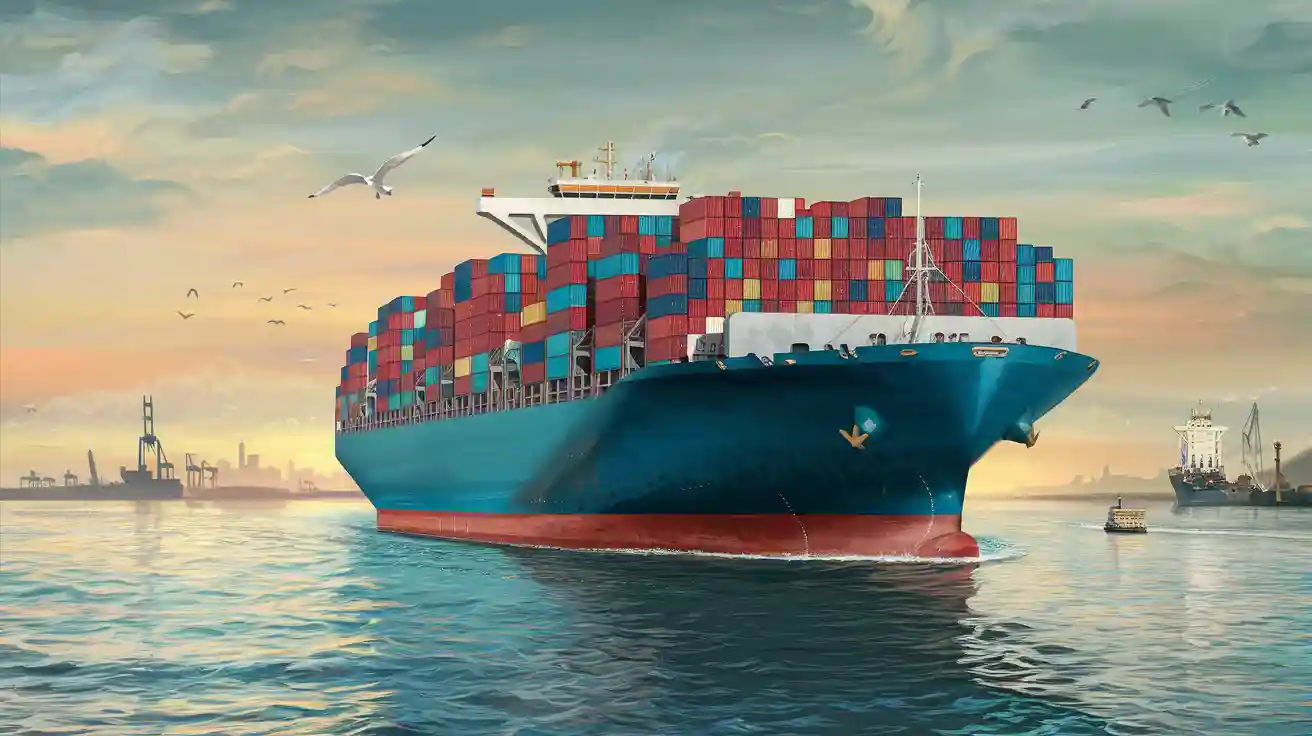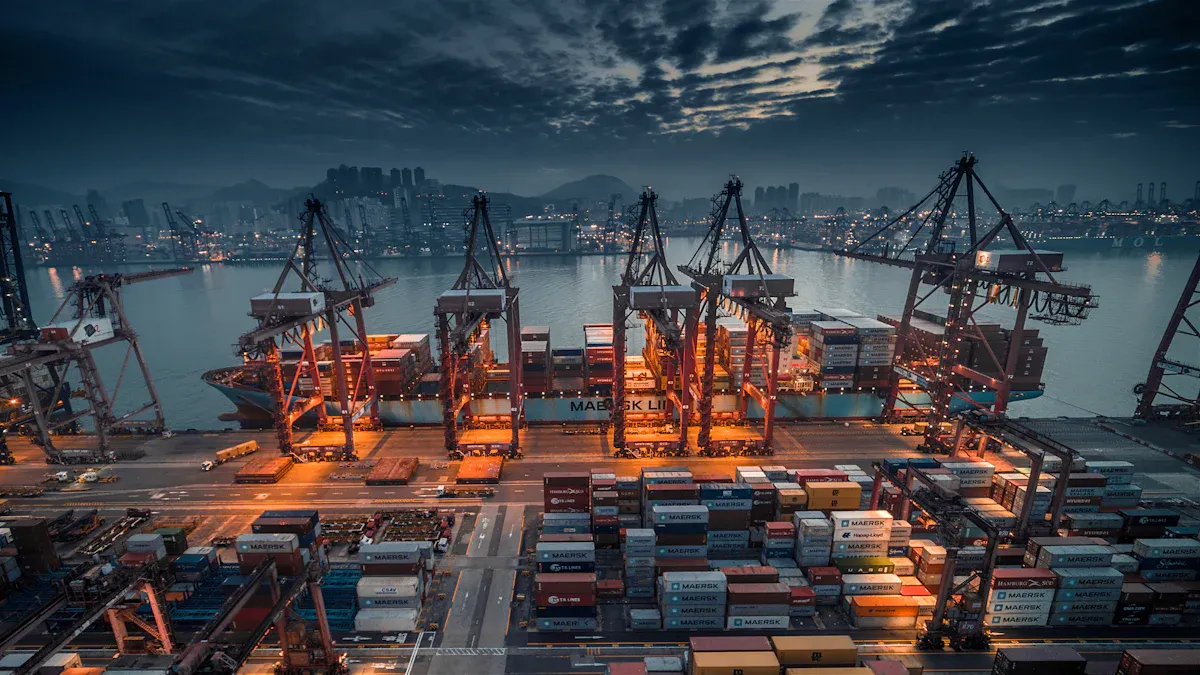Step-by-step Guide to Ocean Freight Shipping for International Trade

Understanding the ocean shipping process is essential for success in international trade. Mastering this process offers several advantages:
Expanded global reach, enabling access to new markets.
Cost-effective solutions for large shipments.
Flexible transportation modes tailored to your needs.
Enhanced security and eco-friendly logistics.
Improved inventory management, aligning supply with demand.
These benefits streamline operations and position your business for growth.
Key Takeaways
Knowing ocean freight shipping is important for global trade success. It saves money and helps you reach more countries.
Picking Full Container Load (FCL) or Less than Container Load (LCL) affects cost and time. FCL is quicker and safer. LCL works well for small loads.
Correct paperwork is needed for easy customs checks. Important papers are the invoice, bill of lading, and packing list.
Understanding Ocean Freight Shipping

What is Ocean Freight?
Ocean freight refers to the transportation of goods across seas using large vessels. This method typically involves standardized containers, such as twenty-foot equivalent units (TEUs), which simplify loading and unloading. Ocean freight is ideal for bulk shipments or oversized items due to its cost-effectiveness. Compared to air freight, which can cost 12–16 times more, ocean shipping offers a more economical solution for long-distance trade. Businesses often rely on this mode for its ability to handle large volumes efficiently.
Why Ocean Shipping is Vital for International Trade
Ocean shipping plays a pivotal role in global trade. Over 90% of international freight shipping depends on maritime transport, emphasizing its importance in connecting economies worldwide. This method accommodates a wide variety of cargo, from bulk commodities like grains to containerized goods such as electronics. Its fuel efficiency makes it the most cost-effective option for long-distance shipping, surpassing air and land transport. By choosing ocean shipping, you can move goods affordably while meeting diverse trade requirements.
Types of Ocean Freight: FCL vs. LCL
When shipping goods internationally, you can choose between Full Container Load (FCL) and Less than Container Load (LCL). FCL involves reserving an entire container for your shipment, ensuring exclusive use and greater security. This option suits larger volumes and offers faster delivery due to minimal handling. On the other hand, LCL allows you to share container space with other shippers, making it a cost-effective choice for smaller loads. However, LCL shipments may face longer transit times and a slightly higher risk of damage due to shared space. Understanding these options helps you select the best fit for your shipping needs while managing ocean freight charges effectively.
Key Participants in International Freight Shipping
Understanding the roles of key participants in international freight shipping is crucial for a smooth shipping process. Each participant contributes to ensuring your goods reach their destination efficiently and cost-effectively.
Roles of Shippers and Consignees
Shippers and consignees play vital roles in the ocean freight process. Shippers handle the preparation and transportation of goods, while consignees manage the receipt and customs clearance at the destination. Here's a breakdown of their responsibilities:
Role | Responsibilities |
|---|---|
Shipper | - Manage cargo documentation. |
- Ensure customs clearance permits and certificates are obtained. | |
- Deliver goods to the point of departure and handle loading/unloading. | |
- Provide transport documents to the consignee. | |
- Arrange cargo transportation insurance and manage related costs. | |
Consignee | - Handle documentation obligations as per the carriage agreement. |
- Interact with the carrier to track cargo and manage transport documents. | |
- Engage a notify party if unable to receive goods personally. | |
- Manage customs procedures and payment of relevant duties and taxes at the destination port. |
Freight Forwarders and Their Importance
Freight forwarders simplify international freight shipping by managing logistics and documentation. They offer several benefits:
Save costs by negotiating better rates and advising on shipping methods.
Streamline the shipping process by handling logistics and export procedures.
Improve transit times by planning efficient routes.
Ensure compliance with regulations to avoid delays.
Provide door-to-door services, reducing risks and simplifying coordination.
Freight forwarders also arrange inland transportation, manage terminal fees, and consolidate cargo for efficiency. Their expertise ensures your shipments move smoothly, reducing total freight cost.
Shipping Lines and Carriers
Shipping lines and carriers are responsible for transporting goods across oceans. They ensure compliance with regulations, provide integrated solutions, and manage cold chain logistics for perishables. Here's a summary of their roles:
Role of Shipping Lines and Carriers | Description |
|---|---|
Compliance with Regulations | Adhere to emissions, fuel standards, and crew safety regulations. |
Integrated Solutions | Offer door-to-door delivery services, coordinating supply chain elements. |
Network Partnerships | Connect inland transport with coastal ports for efficient logistics. |
Cold Chain Logistics | Manage temperature-controlled transport for perishables. |
Freight Forwarding | Collaborate with freight forwarders for route planning and cargo tracking. |
Asset and Network Focus | Focus on assets and networks to facilitate freight movement. |
Customs Brokers and Authorities
Customs brokers and authorities ensure compliance with international trade regulations. They handle documentation, mitigate risks, and enhance supply chain efficiency. Their responsibilities include:
Facilitating customs clearance and ensuring compliance with laws.
Providing guidance on trade agreements to maximize savings.
Identifying potential delays to keep shipments on schedule.
By managing customs paperwork and liaising with government agencies, customs brokers allow you to focus on your core operations while ensuring smooth movement of goods.
Step-by-step Process of Ocean Freight Shipping

Step 1: Preparing Your Shipment
Preparing your shipment is the foundation of a successful ocean freight process. Follow these essential steps to ensure your goods are ready for international freight shipping:
Gather Necessary Documentation: Prepare key documents like the commercial invoice, bill of lading, packing list, shipper’s letter of instructions, and certificate of origin.
Ensure Compliance with Regulations: Adhere to import/export rules and file requirements, such as the Automated Export System (AES).
Choose a Reliable Freight Forwarder: Evaluate their experience, reputation, and services to find the best fit for your needs.
Package and Label Goods Properly: Use durable materials to protect your cargo and ensure labels are clear and compliant with international standards.
Book Your Shipment: Select the most suitable shipping route, considering direct or transshipment options.
By completing these steps, you can avoid delays and reduce ocean freight charges.
Step 2: Booking with Reliable Providers like JUSDA
Booking your shipment with a trusted provider ensures a smooth shipping process. JUSDA offers comprehensive ocean freight solutions tailored to your needs. Their expertise in managing international freight shipping simplifies the process, from route selection to customs clearance. With JUSDA, you gain access to a global network, competitive rates, and real-time tracking, helping you optimize total freight cost and meet delivery deadlines.
Step 3: Packing and Labeling Goods
Proper packing and labeling protect your goods during transit and ensure compliance with customs regulations. Follow these best practices:
Shield goods from external forces, vibrations, and crushing.
Use water-resistant materials to prevent damage from humidity.
Ensure packaging allows efficient stacking to optimize container space.
Comply with ISPM-15 standards for wood packaging.
Add clear labels like "Fragile" or "Handle with Care" for proper handling.
Use padding to absorb shocks and safeguard fragile items.
These measures reduce the risk of damage and ensure your shipment arrives intact.
Step 4: Documentation and Compliance with JusTrade
Accurate documentation is critical for compliance with customs regulations. JusTrade simplifies this process with its intelligent customs clearance platform. Key documents include:
Packing List: Details shipment contents, packaging, and weight.
Certificate of Origin: Confirms the origin of goods for tariff purposes.
Bill of Lading: Serves as a receipt and contract for transportation.
Commercial Invoice: Provides goods’ value and terms for customs.
Insurance Certificate: Covers cargo insurance details.
JusTrade’s platform ensures all documents are accurate and compliant, reducing delays and penalties in the customs clearance process.
Cost Considerations in Ocean Freight
Factors Influencing Ocean Freight Costs
Understanding the factors that impact ocean freight charges helps you plan better and manage expenses effectively. Several elements influence these costs:
Supply and demand dynamics in the shipping industry.
Vessel capacity and utilization rates.
Operational costs, including labor and maintenance.
Industry regulations and compliance requirements.
Infrastructure and technological advancements at ports.
Fluctuating fuel prices.
Cargo type and volume, with specialized goods costing more.
Seasonal variations, such as peak holiday seasons.
Port fees and customs duties, which vary by location.
Additionally, the distance and shipping route play a significant role. Longer routes increase costs, but busy routes may offer cost efficiencies. By understanding these factors, you can better estimate your total freight cost and avoid unexpected expenses.
Tips for Reducing Costs in International Freight Shipping
Reducing costs in international freight shipping requires strategic planning. Here are some practical tips:
Consolidate smaller shipments into larger ones to secure better rates.
Build relationships with carriers and negotiate favorable terms.
Work with a freight forwarder to navigate regulations and find competitive pricing.
Use efficient packaging to maximize container space and minimize damage risks.
Implement supply chain visibility tools to track shipments and identify inefficiencies.
Ensure accurate documentation to avoid delays and penalties.
Regularly evaluate shipping performance to identify areas for improvement.
These strategies not only reduce ocean freight charges but also streamline the shipping process, ensuring timely and cost-effective deliveries.
Avoiding Common Mistakes in Ocean Shipping
Avoiding mistakes in ocean shipping can save you time and money. Here are three common errors and how to prevent them:
Mistiming an Import or Export: Research shipping times and get quotes within a month of your shipment date to avoid delays.
Failing to Properly Insure Goods: Discuss insurance options with your freight forwarder to protect against potential losses.
Choosing the Cheapest Freight Rate: Low rates may lead to complications. Verify the experience and reliability of the provider before booking.
By addressing these issues proactively, you can ensure a smoother shipping process and avoid unnecessary costs.
Enhancing Efficiency with JUSDA’s Solutions
How JUSDA Optimizes Ocean Freight Operations
JUSDA simplifies ocean freight operations by offering tailored solutions for your shipping needs. Their global network ensures reliable transportation across major trade routes. You can benefit from their expertise in managing international freight shipping, which reduces delays and improves efficiency.
JUSDA’s advanced technology integrates real-time data to optimize shipping routes. This reduces transit times and lowers ocean freight charges. Their consolidation services allow you to combine smaller shipments, maximizing container space and cutting costs. By choosing JUSDA, you can streamline your supply chain and minimize your total freight cost.
Tip: Partnering with JUSDA helps you focus on your core business while they handle the complexities of ocean freight logistics.
Leveraging JusTrade for Seamless Customs Clearance
JusTrade, a specialized service under JUSDA, simplifies customs clearance for international freight shipping. Its intelligent platform ensures compliance with regulations, reducing the risk of delays. You can rely on JusTrade to handle documentation like the bill of lading and commercial invoices with precision.
The platform’s AI-driven tools categorize goods accurately and manage cross-border logistics efficiently. This reduces manual errors and speeds up the customs process. JusTrade’s global presence ensures smooth operations in nearly 20 countries, making it an ideal choice for seamless customs clearance.
Real-time Tracking and Transparency with JUSDA
JUSDA provides real-time tracking tools that enhance visibility throughout the shipping process. You can monitor your shipment’s location and status at any time. This transparency helps you plan better and address potential issues proactively.
Their tracking system integrates with supply chain platforms, offering detailed insights into transit times and delivery schedules. This ensures your goods arrive on time, improving customer satisfaction. With JUSDA, you gain control over your shipments, making international freight shipping more predictable and efficient.

JUSDA Solutions
To provide you with professional solutions and quotations.
Mastering ocean freight shipping involves understanding its key steps:
Book space on a vessel by comparing rates and confirming with a carrier.
Track your shipment during transit for peace of mind.
Submit accurate documents like the commercial invoice and bill of lading for customs clearance.
Complete delivery documentation to finalize the process.
Proper documentation is essential for smooth operations. It minimizes risks, ensures compliance with trade laws, and avoids costly delays. Organized documents also improve communication among stakeholders, streamlining import procedures.
Explore JUSDA and JusTrade for expert solutions. Their advanced tools simplify customs clearance and enhance efficiency, making international shipping seamless.
See Also
Discovering Top Global Logistics Firms: A Comprehensive Overview
Exploring Innovations in Sea Freight Logistics for 2024
A Complete Overview of Eco-Friendly Supply Chain Transport
Mastering Cost Reduction in Logistics: A Complete Guide
Enhancing Global E-commerce Success Through Supply Chain Transparency
